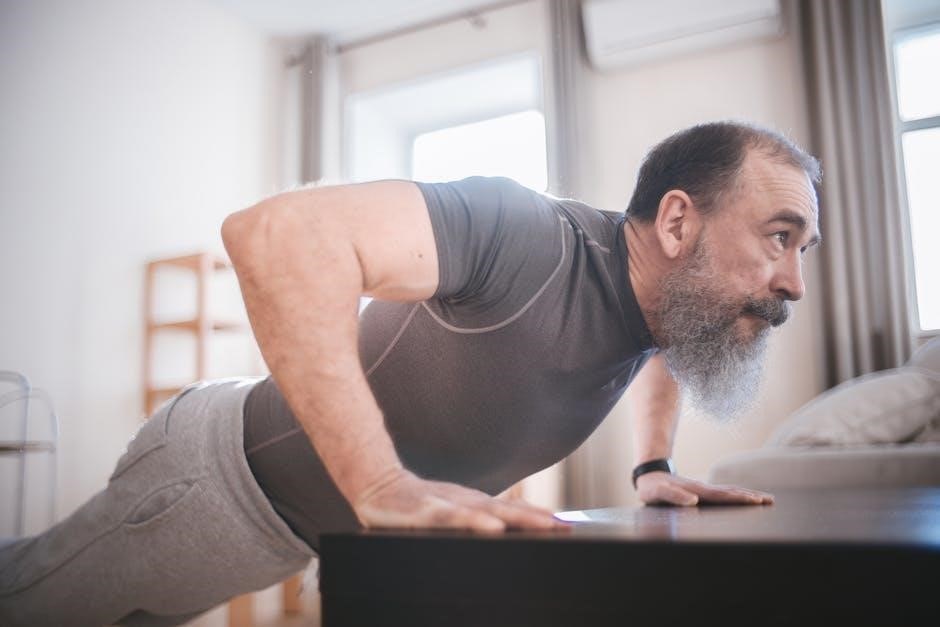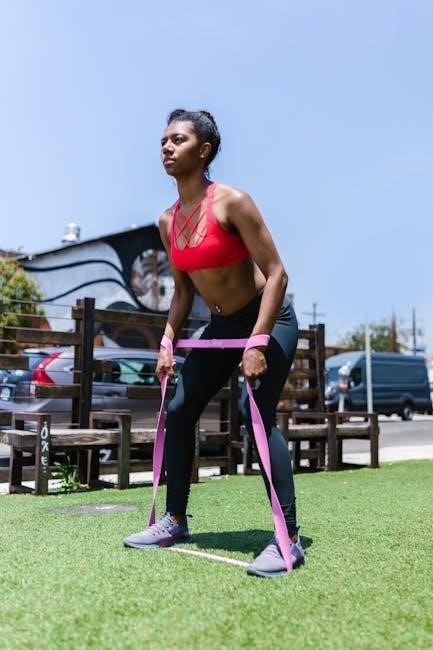Bodyweight exercises are a versatile and effective way to build strength, improve muscle endurance, and enhance overall fitness without relying on gym equipment, offering flexibility and convenience.
What Are Bodyweight Exercises?
Bodyweight exercises are physical activities that use an individual’s own weight as resistance to build strength, endurance, and flexibility. Examples include push-ups, squats, lunges, and planks. These exercises are highly versatile, requiring minimal to no equipment, making them accessible anywhere. They focus on functional movements that improve coordination and balance while enhancing muscle tone. Bodyweight training is suitable for all fitness levels, as exercises can be modified to increase or decrease difficulty. For instance, squats can progress to jump squats, and push-ups can be adjusted with knee variations. This method of training is not only cost-effective but also time-efficient, allowing individuals to maintain fitness without gym memberships or specialized gear.
Advantages of Bodyweight Training
Bodyweight training offers numerous advantages, including cost-effectiveness, convenience, and accessibility. It requires no specialized equipment, making it possible to train anywhere, whether at home, outdoors, or while traveling. Bodyweight exercises promote functional fitness, improving coordination, balance, and overall physical efficiency. They also reduce the risk of injury compared to weighted exercises, as they rely on natural movement patterns. Another benefit is the ability to modify exercises to suit different fitness levels, ensuring progressive overload and continuous improvement. This method of training is sustainable, empowering individuals to take control of their fitness journey without relying on gym memberships or expensive equipment, making it an ideal choice for long-term health and wellness.

Core Bodyweight Exercises
Core bodyweight exercises are foundational movements that target major muscle groups, enhancing strength and flexibility. They include push-ups, squats, lunges, planks, and pull-ups, forming the basis of effective training.
Push-Ups
Push-ups are a fundamental bodyweight exercise that target the chest, shoulders, and triceps. They require proper form to maximize effectiveness and minimize injury risk. Starting in a plank position with hands slightly wider than shoulder-width apart, the body should form a straight line from head to heels. Lower the body until the chest nearly touches the ground, then push back up. Variations like wide-arm, diamond, and incline push-ups can modify difficulty. Regular practice improves upper body strength and endurance, making push-ups a cornerstone of any bodyweight training routine.
Squats
Squats are a fundamental bodyweight exercise that targets the legs, glutes, and core muscles. They are essential for building lower body strength and improving functional movement. To perform a squat, stand with feet shoulder-width apart, engage the core, and lower the body by bending the knees, ensuring the chest remains upright. The goal is to reach a depth where the thighs are parallel to the ground before standing up. Proper form is crucial to avoid injury and maximize effectiveness. Squats can be modified, such as bodyweight squats, or progressed with resistance bands or weights. Regular squat practice enhances mobility, balance, and overall lower body power, making it a key exercise in any bodyweight training program.
Lunges
Lunges are a dynamic bodyweight exercise that targets the legs, glutes, and core muscles, enhancing strength, balance, and coordination. They involve a stepping motion where one leg is brought forward, lowering the body until both knees are bent at 90 degrees. Proper form is essential: keep the front knee over the ankle, chest upright, and engage the core for stability. Lunges can be modified by reducing depth or shortening the stride for beginners. For advanced individuals, resistance bands or weights can be added to increase intensity. Regular lunge practice improves unilateral strength, helping to address muscle imbalances and boost overall lower body functionality. Incorporating lunges into a routine promotes better mobility and athletic performance.
Planks
Planks are a fundamental bodyweight exercise that strengthens the core muscles, including the abs, obliques, and lower back. They improve posture, stability, and overall athleticism by engaging the entire body. To perform a plank, start in a push-up position with hands shoulder-width apart, arms straight, and body in a straight line from head to heels. Hold this position for 20-60 seconds, focusing on maintaining a rigid core and avoiding letting the hips sag. Variations include side planks for targeting obliques and dynamic planks for added intensity. Regular plank practice enhances endurance, reduces injury risk, and supports better movement patterns in daily activities and sports. Consistency is key for building a stronger, more stable core.
Pull-Ups
Pull-ups are a classic bodyweight exercise that targets the upper body, particularly the latissimus dorsi muscles in the back, as well as the arms and shoulders. They are highly effective for building strength and muscle endurance. To perform a pull-up, hang from a bar with an overhand grip, engage your core, and pull yourself up until your chin clears the bar. Proper form is essential to avoid injury and maximize results. For those who find pull-ups challenging, variations like assisted pull-ups or using resistance bands can help build strength. Regular practice improves overall upper body strength, enhances posture, and contributes to better athletic performance. Pull-ups are a versatile and impactful exercise for any fitness routine.

How to Structure a Bodyweight Workout Routine

Define your fitness goals and choose exercises that align with them. Start with foundational movements like push-ups, squats, and lunges. Organize workouts into upper body, lower body, and full-body sessions. Incorporate warm-ups and cool-downs for injury prevention and recovery. Progress by increasing reps, intensity, or exploring variations. Ensure adequate nutrition and sleep to support muscle growth and recovery. Track progress and adjust the routine as needed for consistency and motivation.
Creating a Full-Body Workout Plan
A full-body workout plan using bodyweight exercises targets all major muscle groups. Start with dynamic warm-ups like arm circles and leg swings. Incorporate compound exercises such as push-ups for the chest and shoulders, squats for legs and core, and pull-ups for the back and arms. Add variations like lunges and planks to enhance balance and core strength. Finish with cool-down stretches to improve flexibility. Aim for 3-4 sets of each exercise with 10-15 reps. Adjust intensity by modifying movements or adding resistance bands. Consistency and proper form are key to achieving progressive overload and overall fitness. Rest days are crucial for muscle recovery and growth. Stay hydrated and maintain a balanced diet to support your training. Track your progress and adjust the plan as needed to avoid plateaus and keep challenging your body. This approach ensures a well-rounded and effective workout routine that can be done anywhere, making it ideal for those with limited equipment or space. By focusing on full-body movements, you can improve coordination, strength, and endurance simultaneously, leading to better overall physical fitness and health.
Progressing Over Time
Progressing in bodyweight training involves gradually increasing difficulty to challenge muscles and promote growth. Start with basic exercises like push-ups and squats, then add variations such as diamond push-ups or single-leg squats. Incorporate resistance bands or weighted vests to increase load. Aim to increase reps or sets over time, or reduce rest periods between exercises. For advanced movements, try plyometric variations like jump squats or clapping push-ups. Track your progress by logging workouts and measuring improvements in strength and endurance. Consistency is key, but allow time for recovery to avoid injury. Adjust your routine every 4-6 weeks to keep challenging your body and prevent plateaus. Proper form and gradual progression ensure safe and effective long-term gains. Stay motivated and celebrate small achievements to maintain momentum.
Nutrition and Recovery for Bodyweight Training
Nutrition and recovery are crucial for optimizing bodyweight training results. A balanced diet provides energy and supports muscle repair, while adequate rest prevents overtraining and enhances performance.
Importance of Diet
A well-balanced diet is essential for supporting bodyweight training. It provides the necessary energy and nutrients for workouts, aids in muscle recovery, and helps build lean muscle mass. Including protein-rich foods like lean meats, eggs, and legumes is vital for muscle repair and growth. Carbohydrates, such as whole grains and fruits, supply energy, while healthy fats from nuts and avocados support overall health. Proper hydration is also crucial to maintain performance and recovery. A diet tailored to training needs ensures the body can handle the demands of bodyweight exercises effectively, promoting progress and overall fitness goals.
Role of Rest and Sleep
Rest and sleep are crucial for recovery and progress in bodyweight training. During sleep, muscles repair and rebuild, while hormones like testosterone and growth hormone, essential for muscle growth, are optimized. Adequate rest prevents overtraining, reducing the risk of injury and enhancing performance. Aim for 7-9 hours of quality sleep nightly and incorporate rest days into your routine to allow your body to recover fully. Proper recovery ensures consistent progress and maintains overall physical and mental health, making rest as important as the training itself for achieving fitness goals.
Bodyweight exercises offer a practical and accessible way to achieve fitness goals, requiring minimal equipment and adaptable to any environment. By incorporating push-ups, squats, lunges, planks, and pull-ups into a structured routine, individuals can build strength and improve flexibility. Proper nutrition and adequate rest are essential for recovery and progress. Consistency and gradual progression are key to overcoming plateaus and achieving long-term success. Whether at home or in a gym, bodyweight training provides a sustainable path to enhanced physical fitness and overall well-being, making it a valuable addition to any workout regimen. Embrace this versatile approach to unlock your full potential and maintain a healthy lifestyle.
